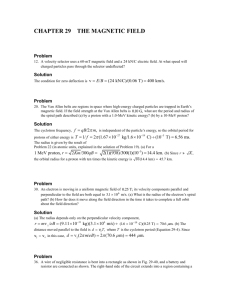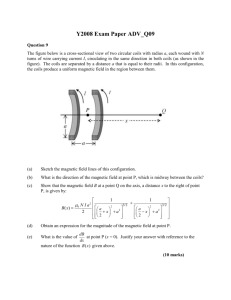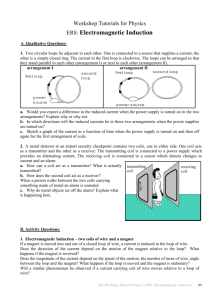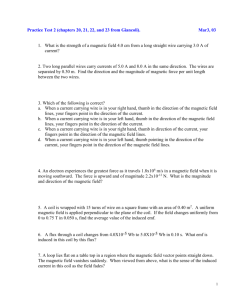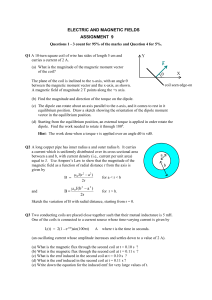Single Stretched Wire - Indico
advertisement
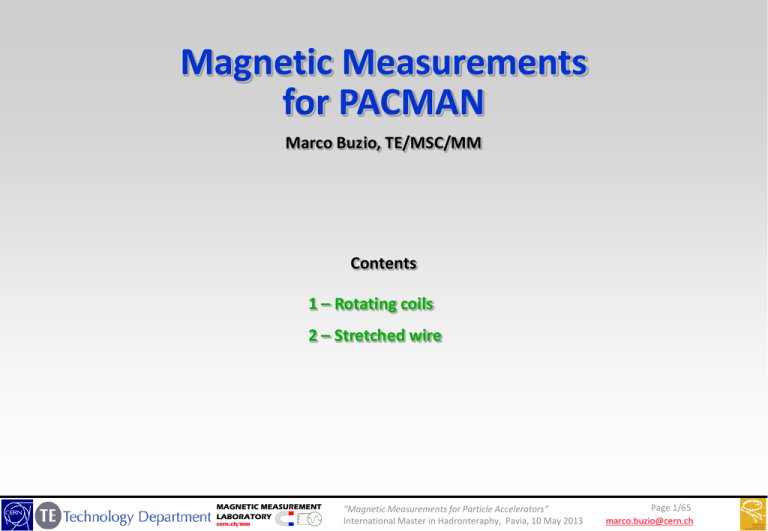
Magnetic Measurements for PACMAN Marco Buzio, TE/MSC/MM Contents 1 – Rotating coils 2 – Stretched wire MAGNETIC MEASUREMENT LABORATORY cern.ch/mm “Magnetic Measurements for Particle Accelerators” International Master in Hadronteraphy, Pavia, 10 May 2013 Page 1/65 marco.buzio@cern.ch Main PACMAN WP 2.2 goal Development of a rotating coil system (single scanning coil and/or coil train) integrated on the PACMAN test stand in bldg. 169 and aimed at field quality (strength, harmonics, direction) measurements of CLIC quadrupoles. Magnetic measurement of the axis: if possible absolute, otherwise in relative (fixed-coil) mode with ultra-high bandwidth and resolution. This implies, within the 3-years span: a dedicated FAME system with an optimized PCB coil(s), FDI, FFMM script etc…. Metrological qualification, cross-checks with other instruments, with documented calibration and test procedures MAGNETIC MEASUREMENT LABORATORY cern.ch/mm “Magnetic Measurements for Particle Accelerators” International Master in Hadronteraphy, Pavia, 10 May 2013 Page 2/65 marco.buzio@cern.ch Search coils • Workhorse of CERN instrumentation park: most accurate and cost-effective method • Size, effective surface, number of turns, resistance, assemblies … must be adapted to the specific requirements of each magnet no commercial solution, in-house R&D • Main parameter: total area exposed to flux change Ac, which determines the peak induced voltage (limited by electronics, typically 5 or 10 V) B n VC A A VC d d B B n dA n dA v B d dt dt A t A A Faraday’s law (total derivative) NT Ac B Vc Ac B t Ac Bv coil rotating, translating or deforming (wire) Fixed coil in a time-varying field Coil rotating at angular speed in stationary, uniform field Coil translating at speed v in stationary field with gradientB MAGNETIC MEASUREMENT LABORATORY cern.ch/mm fixed-coil, time-varying field “Magnetic Measurements for Particle Accelerators” International Master in Hadronteraphy, Pavia, 10 May 2013 Page 3/65 marco.buzio@cern.ch Rotating coils Rotating coils: yield simultaneously field strength, quality (harmonics), direction and center y t ( ) C N L 0 Vcoil dt T z 2n z1n n n1 e in t (0) n rref n 1 n 2D ideal rectangular rotating wr coil geometry z2 wt R2 R0 z1 R1 0 (initial phase of midpoint) x integration constant: lost with fixed coil measurements, irrelevant (unphysical) for rotating coils integration bounds set by precise angular encoder rotation speed fluctuations have negligible effects measured flux depends on both the field and coil geometry Discrete sampling of flux → Fourier components → field harmonics n 1 2 r n 1 ref n FFT n , n (n ) ( 2Nn ) Cn N n n=1, B10 MAGNETIC MEASUREMENT LABORATORY cern.ch/mm n=1, A10 “Magnetic Measurements for Particle Accelerators” International Master in Hadronteraphy, Pavia, 10 May 2013 n=2, B20 Page 4/65 marco.buzio@cern.ch Rotating coil types Tangential coils: • higher signal for the same area (on the boundary of the convergence circle) • blind spot, difficult to align precisely Radial coils • easier to build and to calibrate • sensitive to all harmonics MAGNETIC MEASUREMENT LABORATORY cern.ch/mm “Magnetic Measurements for Particle Accelerators” International Master in Hadronteraphy, Pavia, 10 May 2013 Page 5/65 marco.buzio@cern.ch Coil sensitivity factors N radial coil 0=0, =0 1 A 2 AR0 3 4 5 6 𝑤2 𝐴 + 𝑅02 12 𝑤2 𝐴𝑅0 + 𝑅02 4 𝑤4 1 2 2 𝐴 + 𝑤 𝑅0 + 𝑅04 80 2 𝑤4 5 2 2 𝐴𝑅0 + 𝑤 𝑅0 + 𝑅04 16 6 tangential coil 0=/2, =0 w=2R0sin/2 A 𝛼 𝑖𝑐𝑜𝑠 𝐴𝑅0 2 1 − (1 + 2𝑐𝑜𝑠𝛼)𝐴𝑅02 3 𝛼 −𝑖𝑐𝑜𝑠𝛼𝑐𝑜𝑠 𝐴𝑅03 2 tangential coil 0=/2, =0 0 A 1 (1 + 2𝑐𝑜𝑠𝛼 + 2𝑐𝑜𝑠2𝛼)𝐴𝑅04 5 𝑖 (4𝑐𝑜𝑠 2 𝛼 − 1)𝐴𝑅05 3 iAR0 −𝐴𝑅02 −𝑖𝐴𝑅03 𝐴𝑅04 𝑖𝐴𝑅05 • All coefficients can be calculated from coil length L, width w and radius R0 • All coefficients proportional to total coil area Ac=NTLw • All coefficents increase like radius R0n-1 NB: calibration coefficients can be used at any field level – inherently linear sensor However: S/N at calibration gets better at high field MAGNETIC MEASUREMENT LABORATORY cern.ch/mm “Magnetic Measurements for Particle Accelerators” International Master in Hadronteraphy, Pavia, 10 May 2013 Page 6/65 marco.buzio@cern.ch Why is it difficult to measure small-aperture magnets ? • general problem: static and dynamic deformations, vibrations, alignment, temperature drifts are more difficult to control • Mechanical manufacturing tolerances are fixed=f(tooling) → coil sensitivity coefficient uncertainty 1/r (r=outer rotation radius) N L n T r2n r1n n n n n r r ( n ) (r ) n n r e.g.: radial coil, n>1 • the number of turns available for coils (→ signal level) r2 • Signal level grow with linked flux variation → rn-1 (e.g. radial coil), rn (stretched wire) (field/gradient strength, rotation/translation speed, length, etc. being equal) S/N ratio for quadrupole measurement may vary with r3 r4 …. BUT: small magnets are easier to flip around … Page 7/7 “Magnetic measurements of the Linac4 diagnostic line dipole – first results” MAGNETIC MEASUREMENT LABORATORY cern.ch/mm Coil bucking • The accuracy of higher harmonics measured by individual coils may be affected by geometry errors • Solution = coil bucking (or compensation): suitable linear combinations of coil signals cancel out the sensitivity to the main (and lower) harmonics robustness to mechanical imperfections • Example: in a perfect quadrupole, average gravity-induced sag on a radial coil flux error including mainly B1 and B3 components. A four-coil series/anti-series combination cancels out B2 sensitivity error-free harmonic measurement () B C A Y ideal geometry (no sag) Coil 1 2 3 4 z1 z2 X w A 1 2 3 4 5 6 Sensitivity coefficient C D • • • • • R0 5 flux error () (zoomed) sag-induced vertical eccentricity B D 1 2 3 Coil 1 Coil 2 Coil 3 Coil 4 A A A A Bucked coil: Coil 5 Linear combination (spare) 1-2-3+4 A -2Aw -Aw 0 Aw 2Aw 49 13 1 13 49 𝐴𝑤 2 𝐴𝑤 2 𝐴𝑤 2 𝐴𝑤 2 𝐴𝑤 2 12 12 12 12 12 Arbitrary static coil imperfections cause no concern (effective sensitivities can be calibrated) Position- or time-dependent transversal imperfections errors harmonic n=main order Position- or time-dependent torsional imperfections errors harmonic n=main order -1 Coil design objective: main=main-1=0, maximize |n| with n>main order Additional benefit: common mode rejection, improved S/N (requires separate amplification) MAGNETIC MEASUREMENT LABORATORY cern.ch/mm “Magnetic Measurements for Particle Accelerators” International Master in Hadronteraphy, Pavia, 10 May 2013 Page 8/65 marco.buzio@cern.ch 0 0 𝟒𝑨𝒘𝟐 Effective coil width NT L 0 Bd w( s)B( s)ds B weff L B L weff 1 L B B( s )ds 0 L L NT w( s ) B( s )ds weff 0 L Bd B( s )ds 0 Aeff Lweff Aeff • • • The flux corresponding to a given coil position can be obtained in various ways (flipping or rotating the coil, pulsing the field from zero) L can be considered as known from mechanical measurements General case: unless B(s) or w(s) are constant and can be taken out of the integral sign, the flux cannot be obtained from average width and average field: L 1 L 0 L 1 L 0 • w( s) B( s)ds B( s)ds L 1 L 0 1 w( s)ds Define: effective width (NT gets lumped in for convenience) = average of width weighted with the field considerations made here for a dipole field hold true for other components as well MAGNETIC MEASUREMENT LABORATORY cern.ch/mm “Magnetic Measurements for Particle Accelerators” International Master in Hadronteraphy, Pavia, 10 May 2013 Page 9/65 marco.buzio@cern.ch Linac4 harmonic coil test bench • • • • • Developed for small-aperture Linac4 permanent-magnet and fast-pulsed quads 19 mm, 200~400 mm long quadrupole-bucked coils (difficult measurement: S/N aperture3 !) Harmonic measurements in DC (continuously rotating coil) or fast-pulsed (stepwise rotating) mode. small size flipping the magnet around allows elimination of many systematic errors in-situ calibration technique to improve accuracy despite geometrical coil imperfections 0.010 Coil 1 Nt=100 0.005 Coil 3 Nt=64 0.000 - 0.005 Coil 2 Nt=64 - 0.005 0.000 0.005 0.010 MAGNETIC MEASUREMENT LABORATORY cern.ch/mm “Magnetic Measurements for Particle Accelerators” International Master in Hadronteraphy, Pavia, 10 May 2013 Page 10/65 marco.buzio@cern.ch Innovative miniature coils for CLIC quadrupoles CLIC QD0 prototype 64-layer PCB stack 3-coil dipole- and quadrupole- bucked array can be chained to measure long magnets at once MAGNETIC MEASUREMENT LABORATORY cern.ch/mm “Magnetic Measurements for Particle Accelerators” International Master in Hadronteraphy, Pavia, 10 May 2013 Page 11/65 marco.buzio@cern.ch PCB coil-related R&D themes 1. general improvement of multi-layer PCB coils: track density (currently only ~1/3 of conventional coils), layer referencing and alignment (currently ~0.1 mm) 2. optimization of track layout to minimize sensitivity to production errors 3. improvement of the existing 8 mm rotating PCB coil shaft: mechanical stiffness of the assembly (materials, geometry, resins …), alignment and stability of ball bearings, scaling above and below 8 mm (e.g. is it possible 4 mm for CLIC, 20 mm for Linac magnets, or even more ?) 4. development (as suggested by Stephan) of a more compact Mini Rotating Unit MRU-II, i.e. about 10-12 contacts instead of the current 76, better adapted to small coils, with less angular vibrations 5. PCB-based quench antennas (with compensation) 6. micro PCB connectors for multi-strand wire coils (as suggested by Olaf, to replace the existing micro-soldered connectors that only Lucette knows how to make) 7. large scale PCB fluxmeters: upper limits of current printing, pressing and assembly techniques + new possibilities offered by ELTOS; alternative architectures e.g. multiple mass-produced short boards + suitable inter-board connections 8. quality assurance of PCB fluxmeters: AC measurement of coil width, R/L measurement, calibration of magnetic equivalent coil area and coil distance inside reference magnets 9. micron-level precision coils for high order analog bucking (e.g. integrated circuit - scale fluxmeters) 10. Joe di Marco-style, polyvalent PCB sandwich coil shaft (flexible design, may be very practical for very large diameter rotating systems). Advanced materials (foams, honeycombs etc … for higher stiffness-to-weight ratio) 11. electronic acquisition systems: correction of side effects of high resistance load coils (input impedances, automatic resistance measurement and off-line correction, noise and offsets) 12. software tool to facilitate the design of new PCB coils, bypassing traditional CAD: from geometry specifications (e.g. straight/arc/straight or more realistic continuously varying curve) layer design Gerber format file 13. other techniques alternative to PCB: circuits printed on flexible rolls, inkjet circuit printers Page 12/7 “Magnetic measurements of the Linac4 diagnostic line dipole – first results” MAGNETIC MEASUREMENT LABORATORY cern.ch/mm Single Stretched Wire B stage Reference quadrupole Page 13/7 “Magnetic measurements of the Linac4 diagnostic line dipole – first results” A stage MAGNETIC MEASUREMENT LABORATORY cern.ch/mm Classical Single Stretched Wire • DC operation: nominal field level • AC operation : enhanced sensitivity at very low field levels (e.g. 1 A in LHC cryomagnets), elimination of DC offset (stray fields, remanent …) S0, pitch, yaw A C iterative axis finding Page 14/7 B Gxdy, Gydx field direction (roll) “Magnetic measurements of the Linac4 diagnostic line dipole – first results” field harmonics MAGNETIC MEASUREMENT LABORATORY cern.ch/mm Shape of stretched wire with / without magnetic forces Magnetic Field A stage Y position B stage Mag Force Sag f Mag Force wg 2 l wire 8T 1 2lwire T w Z As tension measurement is affected by friction problems and gauge accuracy, the SSW system measures the fundamental frequency of the wire, which depends uponh its mechanical properties 28.09.2005 MAGNETIC MEASUREMENT LABORATORY cern.ch/mm “Magnetic Measurements for Particle Accelerators” International Master in Hadronteraphy, Pavia, 10 May 2013 Page 15/65 15 marco.buzio@cern.ch Wire selection Page 16/7 “Magnetic measurements of the Linac4 diagnostic line dipole – first results” MAGNETIC MEASUREMENT LABORATORY cern.ch/mm Integrated Strength (Gdl) (5) Magnetic properties of the wire Four different wires have been tested: 0.1mm CuBe wire from California Fine Wire Co, USA 1. 0.1mm Mg wire from California Fine Wire Co, USA 2. 3. 4. SCS-6 Silicon Carbide CuBe 0.13mm CuBe wire from Goodfellow Co, UK Carbon fiber HTA5241 Carbon fiber strand from Toho Tenaz Europe gmbh, type HTA5241 (5). ( 0.078mm silicon carbide, type SCS-9A from Speciality Materials Co, USA) (Note: type 5. could not be magnetically tested because of its high rigidity) Different type of tested wire Slopes of strength for different types of wire in [T/s2] 0.76kA 5kA 11.85kA χ Wire Note: • if strength rises when tension increases, wire is diamagnetic CuBe 0.1mm 30.4 2000 9480 >0 Mg 0.1mm 6.1 500 4977 >0 CuBe 0.13mm 2.3 50 474 <0 - - 380 <0 Multi filament Carbon strand 28.09.2005 MAGNETIC MEASUREMENT LABORATORY cern.ch/mm • If strength falls when tension increases, wire is paramagnetic “Magnetic Measurements for Particle Accelerators” IMMW14 International Master in Hadronteraphy, Pavia, 10 May 2013 Page 17/65 17 marco.buzio@cern.ch Single Stretched Wire Page 18/7 “Magnetic measurements of the Linac4 diagnostic line dipole – first results” MAGNETIC MEASUREMENT LABORATORY cern.ch/mm


